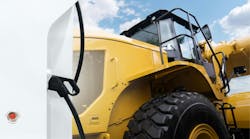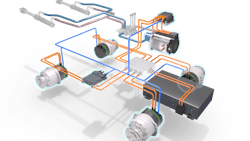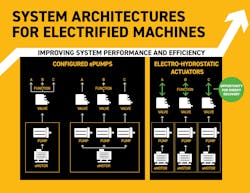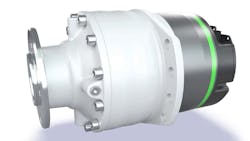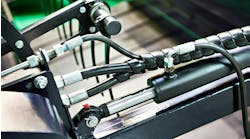Hydraulic systems are vital to the operation of mobile off-highway machines. As electrification increases in this sector, hydraulics will continue to play an important role.
However, to meet the requirements of electric-powered machines and their end users it will be necessary to rethink the design of some hydraulic components and systems.
Improving the efficiency of hydraulics will be an especially important aspect to consider in the years ahead as electrification continues to grow. Creation of more efficient hydraulics will reduce power draw from batteries to ensure longer run times as well as help to reduce the overall size of the batteries required for a machine.
Eric Vives: I really think that electrification is a good way to [bring awareness to] one big shift that our industry of hydraulics has to take [which we can] sum up in moving from a oversized transmission to an energy-sized transmission. Historically, how you size the transmission on a big machine is you take the toughest condition, [such as] the biggest slope that you have to pass, the weight of the machine, the max pressure, and displacement of the pump and the motor. You size the transmission based on the max power or max torque that you need. When you do this with an internal combustion engine (ICE) [it is not as] big of a deal. We won't get the best efficiency from the transmission, but that is okay.
What electrification brings to the table is the price of the machine due to the battery size. If you have poor efficiency for your transmission, you will have to install a bigger battery which means a higher cost of the battery and so higher cost of the machine. So, you move from a world in which the efficiency and the total cost of ownership of the machine is not connected to the efficiency of the machine to a world where you get the impact of the total cost of the machine [as well as] impact on the price of the machine because you will have to have a bigger battery if you have a poor efficiency. I really think that this move to electrification will drive a trend to move from oversized hydraulic transmissions to energy-sized hydraulic transmissions. And it will be a benefit also for machines with a combustion engine because you will save some CO2 (carbon dioxide) and improve the efficiency of the hydraulic transmission; it will [provide a] benefit to the industry.
Power & Motion: What further changes do you see possibly coming to hydraulic system designs as electrification progresses further?
Eric Vives: As I touched on, this idea of efficiency…not only for each hydraulic component but also taking into account the whole transmission is something that will bring transformation to [electric] and also standard machines.
Chris Griffin: To echo what Eric said…certainly a continued focus on efficient system design. Because, as Eric mentioned, with a diesel system you have an unlimited supply of energy, so efficiency isn't that important. But with a battery, it’s not quite that situation so we have to maximize the efficiency of the complete system. The motor and the inverter bring a very high level of energy conversion from the battery to the shaft. But we also have to bring up the hydraulic efficiency, even if it's five or 10 points; it doesn't have to be 100% efficient. It makes a significant impact on the size of the battery, the cost of the battery and the weight of the battery, which affects the energy consumption of the whole machine.
Another area that we see potentially emerging is more of a decentralization of the control system. Typically, a hydraulic machine has a central reservoir, may have a central pump, and then valves to control the different functions. And again, when you have an unlimited supply of energy, you're not worried about wasting it…that's a suitable design. But with electric motor control, we're able to get more power and speed on demand. And as the costs of the electric motor technology comes down, there may be an opportunity for us to split that work between multiple motor-inverter systems and maybe more remote axes of work on a machine can be independently controlled, and then with that independent control you also have the opportunity to capture regenerated energy. If it's something that's being lifted up and then it's being brought down, we might be able to use that energy to recharge the battery. That's probably a little farther off, but we're starting to see whispers of that with some of our customer interactions. To support that, we'll also start to see more local control at the system components such as valves, they'll have more on-board electronics for communicating with the broader control system, typically via CAN, and either take commands or transmit data back to the central control system so that whole energy equation can be managed most efficiently.
Power & Motion: What are some of the biggest challenges you see when it comes to integration of fluid power and electrification technologies, and how can these be overcome?
Chris Griffin: Some of the challenges are changing that way of thinking to focus on efficient system design. And I think [companies] like Parker and Poclain and others, we're doing that with our customers, we're figuring that out. I think the big challenge right now is just electrified systems cost a lot more than their ICE counterparts; depending on who you ask, it's two times or three times more. That's just a challenging financial equation for our customers. And I think that's probably been the major thing that's held us back. If electric systems cost the same and provided the same amount of work, everybody would use it. But we don't have that.
We also have a very patchy regulatory environment. It's a really asymmetric kind of push in different regions. And I think that's confusing a lot of customers as well, certainly in the U.S. as we have a different dynamic going on right now, particularly with respect to regulations around zero emissions. Some of the issues I've seen with the regulations, they tend to be sort of all or nothing; either go full zero emission or nothing. And I think we need to put in place more realistic, regulated changes that allow the market to naturally bring these technologies to the fore as well, because that's the only way everybody's going to make money, and the infrastructure that's required is going to be built. We need to give ourselves time and let the market kind of bring us into a zero-emission future, which I believe it will.
The last challenge is emerging industry standards around functional safety and cyber security. A lot of our products today were not designed with that in mind. So, as we look to future designs, that's going to require some real wholesale design changes, particularly on the controls and the electronics that drive these electrified systems.
Watch more of our discussion with Chris and Eric below to learn about the expertise fluid power companies can bring to the electrification space.
Eric Vives: I really like the point on functional safety and new regulations which are coming. For us, it's a big topic and we're using this electrification trend to step up internally and bring to our customers full safety compliance with our products and solutions. What we are developing for electric we want to be fully safety certified. On the cost topic…our industry is not really a volume driven industry, but our customers have a strong cost competitiveness requirement. And I really think that our main challenge will be [having the capability] to handle the high level of customization and low volumes and at the same time maintaining a competitive cost. I think that having a modular approach [for] what we are developing is key.
[This is] what we are trying to do with our electrohydraulic transmission, which is maintain a standard interface between the different architectures that we are providing. [The same will be the case] with the full-electric in-wheel motor we are developing which will be at bauma. We want to have something that is modular [to handle the] diversity and customization required in a more optimized way. Being able to design and to organize our products in a modular way, I really think that it's a key to addressing this transition to electric in a competitive way.
